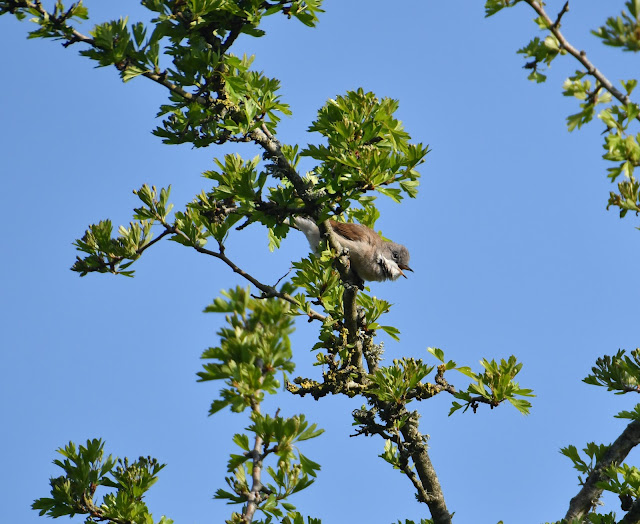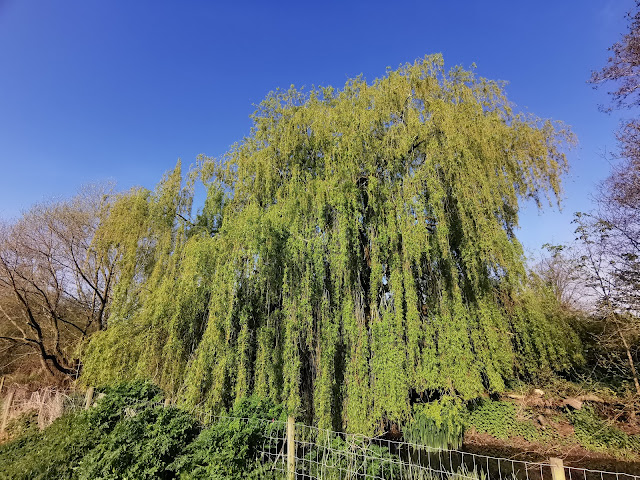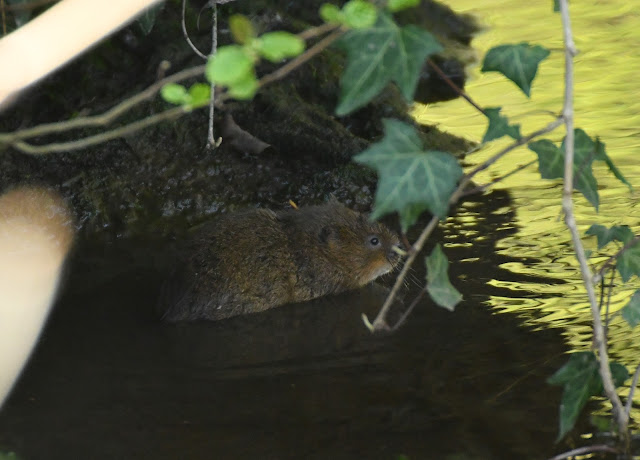To say it's been a while since my last blog is without doubt the understatement of the year.
I've concentrated and been immersed in my Facebook and Instagram pages somewhat due to nature pretty much taking over our previous home. Those that have followed those exploits will be fully aware of what happened there.
Coupled with a year full of life changes I lost sight of the long read but feel it right to return to it now as life has settled into some sort of pattern in our new pad, and we have been able to assess and take stock of what has gone before.
Having only moved three miles north I know the patch very well but it's always exciting to explore places and footpaths never trodden and in more detail.
There are several routes I can take around the area which incorporates all sorts of habitat. From shoreline and lagoons to rivers and woodland, there's so much to see in a relatively short space of time. We are very fortunate to live where we do.
My walk on this day started from home and headed north east to Crofton Old Church called St Edmunds, which dates back to the 12th Century and is mentioned in the Domesday Book.
It was sunrise as I walked through the graveyard and past the pretty little chapel. There was a thick layer of dew on the grass which helped the birds find worms on the surface for their young while the birdsong echoed around the mature trees that pepper the cemetery.

After passing through the Church grounds I headed along Oakcroft Lane towards Mays Lane to Newlands Farm which was my next port of call. Little Owls had a brood here last year in the farm buildings but I couldn't locate them this time.
It's possible they have moved territory as a new bypass has been constructed that runs right through the farm fields and past the buildings. It's due to open shortly which will clearly have a negative impact of the wildlife surrounding it. Not least with pollution and roadkill.
I crossed the main road and onto the footpath that bisects the arable farmland, looking back south to Oakcroft Lane with the impressive Black Poplars that line the road. Behind that, the field is due to have a housing estate built upon it soon. It seems there's no end in sight to fill in the green spaces that surround us.
Black Poplar Leaf, freshly emerged.
The new bypass was being inspected by a gathering of Carrion Crows. Somehow I think the boy racers won't be adhering to the 50mph speed limit when it opens which I think is excessive anyway.
The dew lay like a moist blanket across the grasses and Dandelion seed heads.
Cow Parsley
I would normally cross the bridge and cut across the valley floor to the canal path on the opposite side but the path is still flooded as it does through Winter and into Spring - No wonder the spot is called Posbrook Floods - so I had to take the longer circular route into Titchfield to pick up the path at Bridge Street at it's northern end.
Immediately I picked up on the scratchy song of another Whitethroat.
This time I had some great views as it called while also feeding in the Willow trees, Bramble and Hawthorns.
Posbrook floods is bordered to the North by Bridge Street Floods. Both areas remain underwater throughout Autumn and Winter which provides great habitat for waders and wildfowl. Usually by the end of Spring it begins to dry up. If I think back to twenty years ago, it never used to flood at all. Climate change in action quite clearly.In the fields opposite them is where the horses roam and a place where it's often easy to see Wheatear and Redstart on their way back from Africa. This season has proved very thin on the ground so far with migrants. Even the Swallows and Martins have been almost non existent. I always wonder if they will ever make the journey again and this year is making me fear the worst. I know they will arrive soon but every year they get less and less.
There were a few birds feeding beneath the Oaks such as this Song Thrush however
And in the trees I managed another distant glimpse of a male Blackcap
It has a habit of being unobtrusive and difficult to see, it lived up to that reputation
My usual shot of the oak tunnel. It always draws my lens as the seasons progress and this is the typical fresh Spring photo. Such an inspiring time of year with the new lime green foliage before it darkens into Summer
Although many species are in decline. One that bucks that trend is the Cettis Warbler. Pronounced with a 'Ch' this warbler is even more secretive than the Blackcap. Only in April and May is it possible to see this subtle little bird take centre stage and proclaim it's territory with a song to make itself known.
It's one of the loudest in the bird kingdom and one many people have asked me about as I walk the path here. It is usually heard but not seen.
I find it quite amazing that some trees are beginning to bloom while others of the same species not too far away are still to show their hand. Some Oaks are, such as this example, while others are still relatively bare.
The Weeping Willows are all well endowed by now however.
As I slowly meandered my way South along the canal the onomatopoeic sounds of Chiffchaffs stuttered out from the trees and scrub belt every so often. These diminutive Warblers always used to migrate to Africa at the end of every Summer season but with climate changing, some stay for the Winter in the South of the UK.
Long Tailed Tits busied themselves in pairs along the hawthorns of the canal. I found a nest deep in the hedge. A wonder of camouflage and elasticity. Being made from mosses, lichen and spiders webs, it can expand as their chicks grow larger without breaking it's structure.
More Stock Doves called from the trees. I do have a love for these doll faced birds but to some, if you put on a white collar and make it bigger it turns into a Woodpigeon which is much derided and unloved, probably due to it being so common, raiding bird feeders and having rather large droppings !
Live and let live I say.
If ever there was the quintessential sound of Spring then the Cuckoo would be the one. Their numbers are declining rapidly so to hear one along the valley was a joy. Finding it was a different story entirely.
They always seem to inhabit the tree belt on the opposite side with the sun behind, so all we ever seem to see is it's silhouette. You'll have to trust me that the dark shape in the centre of the tree is said bird !
To ease my frustration of not having a closer encounter with the Cuckoo -Another onomatopoeic bird - a Small Tortoiseshell settled near my feet. Another species in huge decline, although the last few years seem to have been kinder towards this beautiful species of Butterfly.
From species that struggle to one that has expanded it's range and is thriving. Mediterranean Gulls used to be a rare sight in the UK. Now they are a common sight and starting to breed along the South Coast and north up to Norfolk.
The reason for their activity as I reached middle distance on the canal path was due to the tractor ploughing the field. As it unearthed all manner of invertebrates, the Black Headed and Mediterranean Gulls descended in a squawking fury as they fought over the morsels.
More Black Poplars with their distinctive fresh leaved auburn colour lined the footpath across the arable fields.
Now the season is lengthening, more and more butterflies are on the wing. At the moment, it's the regular early risers, in this case a male Green Veined White.
My walk from the previous weekend took in the same path and at the very same point we saw a rare Water Vole sneak around the base of the tree in the canal. Back then we couldn't relocate it. This time I was very lucky. It showed very well indeed as did two others. I waited for a few minutes, watching them swim underwater from bank to bank without surfacing, clearly using underwater entrances. Then appearing from a well camouflaged burrow on the bank and tucking into some vegetation.
Occasionally one would sit for a few seconds before swimming along the surface right in front of me. Their eyesight isn't the best but smell and hearing is, so it's best to wait quietly.
At one stage a man came along with his two dogs, one wanted to jump in right where I stood looking at a vole. I asked politely if he could control his dog which he did without any fuss so the vole went undisturbed. That's not always the case. Many dogs are allowed to swim in the canal by their owners. If you complain, you often get abuse so it made a change for someone to comply for which I thanked him.
Water Voles were once very common. I remember sitting for ages at my local river as a child, either fishing or watching nature and seeing them swim past regularly. Numbers began to decline in the 40's and 50's due to poor farmland management leading to habitat loss. Then in the 80's and 90's American Mink escaped from fur farms and decimated numbers further.
Thanks to a control of Mink numbers and large reintroductions, the Voles are hanging on but estimates say that they declined by 90% from 1989 to 1998. Hopefully that decline has stopped or even begun to reverse in some areas of the UK.
Around my patch several hundred where released a few years ago which seems to have had a positive impact. I see them regularly along the canal path and in Titchfield Haven Nature Reserve itself. Even having one appear in our garden last month, which for a place not that close to a decent water body is great news. If I see any, or any mammal for that matter, I record it on my app from the Mammal Society. This provides them with a great database to follow the trends of animals and what can be done to help them where it's needed.
As I watched it swim in front of me, I couldn't help but chuckle, as it reminded me of a puppet character from an anarchic comedy series from the 80's. Those of a certain age might remember 'The Young Ones' starring Rik Mayal and Arian Edmondson. Adrian's character 'Vyvian' had a pet hamster called SPG (Special Patrol Group) which looked very much like this Water Vole and even swam in one episode called 'Flood'
One sat for a few seconds just when the dog appeared. I calmly told the dog to stay, trying not to disturb the Vole as I waited for the owner to arrive and tell him.
Other species live alongside the Voles such as the Moorhen. Much overlooked, it's quite a pretty water bird with it's red eye and bill. This lacks the webbed feet that Coot have. Probably better to spread across well vegetated marshy areas, whereas Coot often swim in more open water.
I left the Water Voles in peace to complete the last few hundred yards of the canal path.
All the while Chiffchaffs still sang around me.
More Butterflies flitted along the path, this time a Small White stopped on a Dandelion for some nectar.
Soon the real specialist Butterfly species will be on the wing. Something we always look forward to
One of my favourite trees, the Lombardy Poplar line a short section of the canal. They remind me of the local recreation ground as a child, the wind whipping them around and the sound of the leaves rustling high up while the trains used to trundle behind them with a 'clickety-clack' on the rails as they left our local station.
My navigation of the canal path was done. I'd reached the shore and the nature reserve.
I could hear the scratchy yet tuneful song of a newly arrived Sedge Warbler. They love nesting in reed beds while using small bushes as singing posts. Having found it's perch, I homed in on it's location. The sun was behind it which wasn't perfect but with some camera adjustment I managed to show it better than just a silhouette.
Then it moved around into the sun for some slightly better views
I popped into the reserve for a few minutes. The cacophony of the gulls already apparent even before I entered the first hide.
Two Black headed Gulls used the Bearded Tit platform in the area leading up to the hide, probably for some brief respite to the bedlam that ensued on the scrapes on the other side of the hide.
The noise as you open the windows is quite something as the gulls squabble, mate and make nests on the islands of the scrapes. If you saw my short film from earlier on in the week, you'll know what I mean. Some of you have visited the reserve so you'll be fully aware of the din they make !
Still, it's great to see life flourishing like this. Black Headed Gulls that make up the majority of the breeding birds here are in decline despite the numbers you see here, so this is an important breeding site for them.
My circular walk almost complete, I left the sea wall, past the harbour with one more look up the Meon River in the reserve just as it exits under the bridge and into the Solent. The spent golden reedbed was beginning to give way to new green shoots as the cycle of life continues. Like the tide of the sea, the changing of seasons is an unstoppable force despite what the human race tries to throw against it and it's something I love watching and recording no matter what season is upon us.
The title of this post is a line taken from the poem, Spring is Come by Samuel Francis Smith
You can read it by clicking on the link here...
.JPG)







.JPG)
.JPG)
.JPG)
.JPG)

.JPG)


.JPG)
.JPG)

.JPG)










.JPG)


.JPG)

.JPG)

.JPG)



.JPG)






.JPG)



.JPG)

.JPG)
.JPG)







.JPG)







.JPG)


.JPG)



.JPG)
















.JPG)

